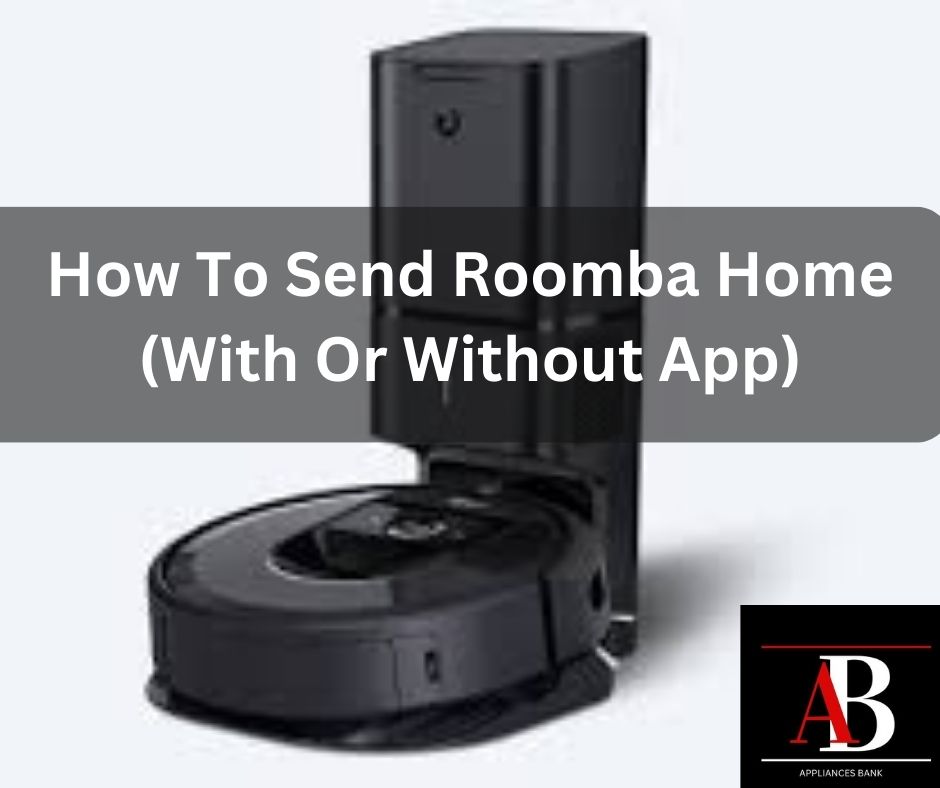“When a cleaning cycle is complete, do you get tired of having to manually direct your Roomba back to its docking station? In this blog article, we’ll explain how you can quickly send your Roomba home with a single button push. We have you covered whether you have a Roomba 600, 700, 800, or 900 series machine. Learn how to make using your Roomba even more convenient by reading on.”
Before starting first ensure the Docking Station
If you want Roomba to return to the docking station, make sure your home base (docking station) is correctly powered and connected.
“It’s essential to confirm that the home base (docking station) is correctly charged and connected before you send your Roomba home. Your Roomba won’t be able to return to its charging station if the home base isn’t operating properly. So, please make sure the socket is functional and the power wire is plugged in. You may send your Roomba home if everything is in working condition.”

How To Send Roomba Home Using the app
Using the Roomba Home app is one of the simplest methods to send your Roomba home. The software is free to download from the App Store or Google Play and is compatible with both iOS and Android smartphones. Once you’ve loaded the app and linked it to your Roomba, you can easily return it back to its docking station by following a few easy steps.
- On your mobile, launch the Roomba Home app.
- Verify that your Roomba is linked to the app and connected to the same Wi-Fi network as your mobile device.
- Once you’ve connected, you’ll see a screen that displays the status of your Roomba.
- You’ll notice a button labeled “Send Roomba Home” or “Dock” at the bottom of the screen.
- When you press the button, your Roomba will begin to move toward its docking station.
- When your Roomba reaches the docking station, it will dock and begin charging automatically.
How To Send Roomba Home Without App
it is depending on the series of Roomba you have.
You may return the Roomba to its docking station by pushing the “clean” button twice in short succession. After that, the Roomba will cease cleaning and return to its docking station.
How To Send Roomba Home With Alexa
Without using the app or pressing buttons on the Roomba machine, you can easily operate your Roomba by sending it home using Alexa. Here’s how to go about it:
- Verify that your Roomba is connected to your Wi-Fi network and configured using the Roomba Home app.
- Check to see if your Alexa device and Roomba are both linked to the same Wi-Fi network.
- Open the Alexa app on your smartphone and navigate to the “Skills & Games” menu.
- Look for and enable the “Roomba” skill.
- Once activated, you may operate your Roomba with voice commands.
- Say “Alexa, tell Roomba to go home” or “Alexa, ask Roomba to dock” to send your Roomba back to its docking station.
- Roomba will cease cleaning and return to its docking station when Alexa confirms the demand.
Remember that this functionality will only function if you have a suitable Roomba model that is linked to the Roomba Home app. If you are unsure about compatibility, please consult the Roomba Home app or the iRobot website.
Why Does Roomba Not Go Home?
There are several reasons why a Roomba might not return to its docking station:
- Power issues: The Roomba will not be able to return to its charging station if the home base (docking station) is not correctly connected in or receiving power.
- Physical impediments: If there are any physical impediments in the Roomba’s path back to the docking station, it will be unable to return home.
- If the Roomba’s home base is dusty or cluttered, it may be unable to dock correctly.
- Low Battery: If the Roomba’s battery is depleted, it may be unable to return to the docking station.
- Issues with software and firmware: The Roomba’s software or firmware may be out of date or malfunctioning in some situations, preventing it from returning home.
- Incorrect Home Base placement: If the Home Base is not positioned correctly or in an area unfamiliar to Roomba, it may be unable to identify it and return home.
- If there are other remote controllers in the neighborhood, or if the Roomba is operated by another device, it may not respond to the instruction to return home.
- Mechanical problems: If the Roomba’s wheels, sensors, or other mechanical components are broken, it may be unable to return to the docking station.
If you encounter this problem, it is recommended that you check the power supply, clean the home base, check the battery, update the software and firmware, inspect the home base placement, check for remote control interference, and check the mechanical parts of the Roomba before attempting to use it again. If the issue persists, please contact iRobot customer service for assistance.
Will Roomba return to base on its own?
Yes, Roomba will return to its docking station on its own when the battery runs out or at the conclusion of a cleaning cycle, as long as the home base is properly connected and charged and there are no physical obstacles in its path.
How long does it take for Roomba to find a home?
It is determined by the Roomba type and the size of the area to be cleaned. Roomba is programmed to return to its home base when its battery runs low or when the cleaning cycle is complete. Roomba uses an innovative navigation system to map out the area to be cleaned and devise a strategy for returning to the home base. If Roomba needs to travel a greater area, it will take longer to make its way back. Roomba should take about 15-20 minutes to return to its home base on average, but this can vary depending on the specific conditions of the environment.
Why does Roomba not go straight home?
Roomba does not come home because it employs an advanced navigation system to map out the region it is the cleaning and devise a strategy for returning to the home base. It navigates and avoids obstructions using sensors and cameras, which may lead it to take a longer journey. Furthermore, if the Roomba reaches a new region, it will take longer to map the area and return to the home base. These can cause Roomba to not return home.
Conclusion
Finally, returning Roomba to its docking station is as simple as pressing a button on the Roomba device, the Roomba Home app, or Alexa voice commands. However, certain problems, like power difficulties, obstructions, a dirty home base, a low battery, software and firmware issues, incorrect home base location, remote control interference, and mechanical faults, might prohibit Roomba from returning home. Before sending Roomba back home, it is critical to consider these issues. Roomba uses a complex navigation system to map out the area it is cleaning and devise a strategy to return to the home base, which may lead it to deviate from its intended path. Overall, Roomba should be able to return to its docking station without issues with proper maintenance and troubleshooting.



